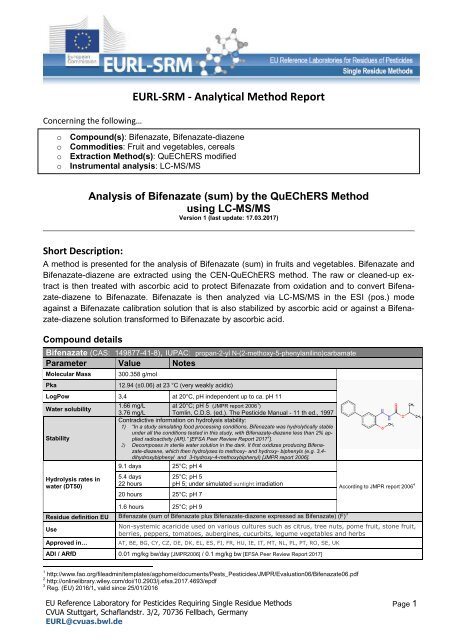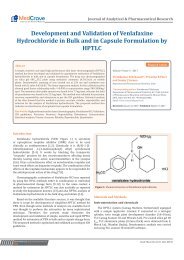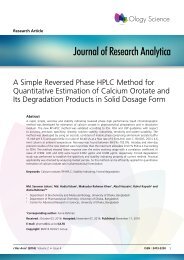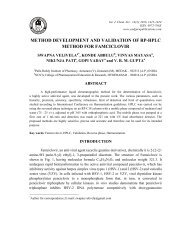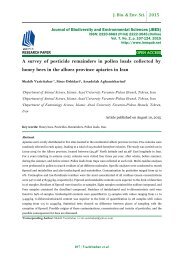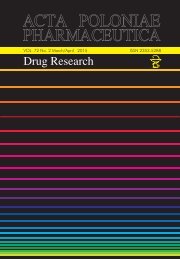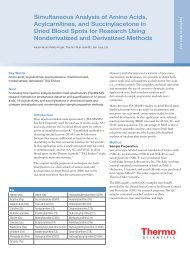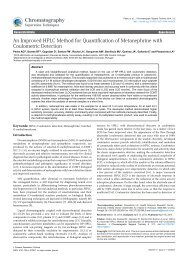extract Bifenazate-diazene Bifenazate-diazene
meth_Bifenazate_EurlSRM
meth_Bifenazate_EurlSRM
Create successful ePaper yourself
Turn your PDF publications into a flip-book with our unique Google optimized e-Paper software.
Concerning the following…<br />
EURL-SRM - Analytical Method Report<br />
o Compound(s): <strong>Bifenazate</strong>, <strong>Bifenazate</strong>-<strong>diazene</strong><br />
o Commodities: Fruit and vegetables, cereals<br />
o Extraction Method(s): QuEChERS modified<br />
o Instrumental analysis: LC-MS/MS<br />
Analysis of <strong>Bifenazate</strong> (sum) by the QuEChERS Method<br />
using LC-MS/MS<br />
Version 1 (last update: 17.03.2017)<br />
Short Description:<br />
A method is presented for the analysis of <strong>Bifenazate</strong> (sum) in fruits and vegetables. <strong>Bifenazate</strong> and<br />
<strong>Bifenazate</strong>-<strong>diazene</strong> are <strong>extract</strong>ed using the CEN-QuEChERS method. The raw or cleaned-up <strong>extract</strong><br />
is then treated with ascorbic acid to protect <strong>Bifenazate</strong> from oxidation and to convert <strong>Bifenazate</strong>-<strong>diazene</strong><br />
to <strong>Bifenazate</strong>. <strong>Bifenazate</strong> is then analyzed via LC-MS/MS in the ESI (pos.) mode<br />
against a <strong>Bifenazate</strong> calibration solution that is also stabilized by ascorbic acid or against a <strong>Bifenazate</strong>-<strong>diazene</strong><br />
solution transformed to <strong>Bifenazate</strong> by ascorbic acid.<br />
Compound details<br />
<strong>Bifenazate</strong> (CAS: 149877-41-8), IUPAC: propan-2-yl N-(2-methoxy-5-phenylanilino)carbamate<br />
Parameter Value Notes<br />
Molecular Mass<br />
Pka<br />
300.358 g/mol<br />
12.94 (±0.06) at 23 °C (very weakly acidic)<br />
LogPow 3,4 at 20°C, pH independent up to ca. pH 11<br />
Water solubility<br />
Stability<br />
Hydrolysis rates in<br />
water (DT50)<br />
1.66 mg/L at 20°C; pH 5 (JMPR report 2006 1 )<br />
3.76 mg/L Tomlin, C.D.S. (ed.). The Pesticide Manual - 11 th ed., 1997<br />
Contradictive information on hydrolysis stability:<br />
1) “In a study simulating food processing conditions, <strong>Bifenazate</strong> was hydrolytically stable<br />
under all the conditions tested in this study, with <strong>Bifenazate</strong>-<strong>diazene</strong> less than 2% applied<br />
radioactivity (AR).” [EFSA Peer Review Report 2017 2 ].<br />
2) Decomposes in sterile water solution in the dark. It first oxidizes producing <strong>Bifenazate</strong>-<strong>diazene</strong>,<br />
which then hydrolyses to methoxy- and hydroxy- biphenyls (e.g. 3,4-<br />
dihydroxybiphenyl and 3-hydroxy-4-methoxybiphenyl) [JMPR report 2006].<br />
9.1 days 25°C; pH 4<br />
5.4 days<br />
22 hours<br />
20 hours 25°C; pH 7<br />
1.6 hours 25°C; pH 9<br />
25°C; pH 5<br />
pH 5; under simulated sunlight irradiation<br />
Residue definition EU <strong>Bifenazate</strong> (sum of <strong>Bifenazate</strong> plus <strong>Bifenazate</strong>-<strong>diazene</strong> expressed as <strong>Bifenazate</strong>) (F) 3<br />
Use<br />
Approved in…<br />
According to JMPR report 2006 4<br />
Non-systemic acaricide used on various cultures such as citrus, tree nuts, pome fruit, stone fruit,<br />
berries, peppers, tomatoes, aubergines, cucurbits, legume vegetables and herbs<br />
AT, BE, BG, CY, CZ, DE, DK, EL, ES, FI, FR, HU, IE, IT, MT, NL, PL, PT, RO, SE, UK<br />
ADI / ARfD 0.01 mg/kg bw/day [JMPR2006] / 0.1 mg/kg bw [EFSA Peer Review Report 2017]<br />
1 http://www.fao.org/fileadmin/templates/agphome/documents/Pests_Pesticides/JMPR/Evaluation06/<strong>Bifenazate</strong>06.pdf<br />
2 http://onlinelibrary.wiley.com/doi/10.2903/j.efsa.2017.4693/epdf<br />
3 Reg. (EU) 2016/1, valid since 25/01/2016<br />
EU Reference Laboratory for Pesticides Requiring Single Residue Methods<br />
CVUA Stuttgart, Schaflandstr. 3/2, 70736 Fellbach, Germany<br />
EURL@cvuas.bwl.de<br />
Page 1
<strong>Bifenazate</strong> <strong>diazene</strong> (CAS: 149878-40-0),<br />
IUPAC: <strong>diazene</strong>carboxylic acid, 2-(4-methoxy-[1,1'-biphenyl], 1-methylethyl ester<br />
Parameter Value Notes<br />
Molecular Mass<br />
Pka<br />
LogPow<br />
Water solubility<br />
Stability<br />
Hydrolysis rates in<br />
water (DT 50)<br />
Residue definition EU<br />
Approved in…<br />
ADI / ARfD<br />
298,34 g/mol<br />
Not ionizable<br />
3.8<br />
4.48<br />
Very low<br />
BVL 4<br />
pH independent (calculated by Chemicalize)<br />
Decomposed by alkaline media to produce methoxy- and hydroxy- biphenyls.<br />
(e.g. 3-hydroxy-4-methoxybiphenyl).<br />
58 hours pH4<br />
50 hours pH5<br />
18 hours pH7<br />
0.28 hours pH9<br />
<strong>Bifenazate</strong> (sum of <strong>Bifenazate</strong> plus <strong>Bifenazate</strong>-<strong>diazene</strong> expressed as <strong>Bifenazate</strong>) (F)<br />
AT, BE, BG, CY, CZ, DE, DK, EL, ES, FI, FR, HU, IE, IT, MT, NL, PL, PT, RO, SE, UK<br />
The finalisation of the toxicological assessment of <strong>Bifenazate</strong>-<strong>diazene</strong> is pending 5 .<br />
N<br />
H 3 C<br />
O<br />
CH 3<br />
O<br />
N<br />
O<br />
CH 3<br />
According to JMPR report 2006<br />
Materials 6 :<br />
<strong>Bifenazate</strong> (purity 98%) was purchased from Dr. Ehrenstorfer GmbH, (Cat #: C10579500)<br />
<strong>Bifenazate</strong>-<strong>diazene</strong> (purity 99.9%) was a kind gift by the applicant company, an acetonitrile<br />
solution (100 µg/mL) may be purchased from HPC Standards GmbH; (Cat #:676338)<br />
Chloryrifos (diethyl D10) (purity 97%, isotopic purity 99%) was purchased from LGC (Cat #:<br />
DRE-C11600100)<br />
Stock solutions of native <strong>Bifenazate</strong>, <strong>Bifenazate</strong> <strong>diazene</strong> and Chlorpyrifos-D10 at 1 mg/ml<br />
was prepared by dissolving 15mg of the compound in 1 mL acetonitrile and filling it up to 15<br />
mL with acetonitrile<br />
Working solutions were prepared by appropriately diluting stock solutions with acetonitrile<br />
Ascorbic acid reagent grade, crystalline was purchased from Sigma-Aldrich (Cat #: A7506<br />
Sigma)<br />
Ascorbic acid solution 30% (w/w) was prepared by dissolving 3 g of ascorbic acid in 10 mL<br />
water. The solution is shaken until ascorbic acid is completely dissolved.<br />
All other materials and chemicals used as listed in EN 15662<br />
Apparatus and Consumables 6 :<br />
Use materials described in the QuEChERS standard procedure (EN15662). As a mechanical shaker<br />
you can use a horizontally or vertically reciprocating shaker or a rotatory shaker (e.g. HS260 by IKA<br />
or GenoGrinder by Spex or SSL1 Labscale Orbital Shaker by Stuart). To filter the <strong>extract</strong> use e.g.<br />
polyester disposable syringe filters of 0.45 μm pore size.<br />
4 http://www.bvl.bund.de/SharedDocs/Downloads/04_Pflanzenschutzmittel/01_zulassungsberichte/006823-00-<br />
00.pdf?__blob=publicationFile&v=3<br />
5 http://onlinelibrary.wiley.com/doi/10.2903/j.efsa.2017.4693/epdf<br />
6 Disclaimer: Names of companies are given for the convenience of the reader and do not indicate any preference by the EURL-SRM<br />
towards these companies and their products<br />
EU Reference Laboratory for Pesticides Requiring Single Residue Methods<br />
CVUA Stuttgart, Schaflandstr. 3/2, 70736 Fellbach, Germany<br />
EURL@cvuas.bwl.de<br />
Page 2
Analytical Procedure<br />
Extraction:<br />
Apply the citrate buffered QuEChERS (EN 15662). Weigh 10 g of frozen fruit or vegetable homogenate<br />
or 5 g of cereals; adjust water content to 10 mL where necessary, add 10 mL acetonitrile and<br />
internal standard (e.g. 100 µL of an appropriately concentrated solution of Chlorpyrifos D10). Shake<br />
15 min using a mechanical shaker. Add a mixture of 4 g MgSO 4, 1 g NaCl, 1 g trisodium citrate dihydrate<br />
and 0.5 g disodium hydrogen citrate sesquihydrate, shake 1 min and centrifuge.<br />
Cleanup: Cleanup via dispersive SPE using PSA-Sorbent as described in EN15662 is optional for<br />
fruits and vegetables.<br />
Transformation of <strong>Bifenazate</strong>-<strong>diazene</strong> to <strong>Bifenazate</strong> and <strong>Bifenazate</strong> stabilization: Transfer 1<br />
mL of raw or cleaned-up <strong>extract</strong> into an auto-sampler vial, add 25 µL aqueous ascorbic acid solution<br />
(30 % w/w) and leave the vial standing for >15 hours (e.g. overnight) before LC-MS/MS analysis.<br />
Figure 1: Typical progress of the transformation reaction in cucumber <strong>extract</strong>s<br />
Preparation of calibration standards: Matrix-matched calibration standards are prepared using an<br />
<strong>extract</strong> of a blank commodity produced as described above, however without addition of an internal<br />
standard. Spike the blank <strong>extract</strong> with appropriate amounts of <strong>Bifenazate</strong> and internal standard and<br />
add 25 µL of the aqueous ascorbic acid solution (30 % w/w)to each vial to stabilize <strong>Bifenazate</strong>. If the<br />
sample contains mainly <strong>Bifenazate</strong>-<strong>diazene</strong> it is advisable to prepare the calibration solution with<br />
<strong>Bifenazate</strong>-<strong>diazene</strong> and to conduct the transformation to <strong>Bifenazate</strong> as described above.<br />
Note: If the sample <strong>extract</strong> is found to exclusively contain <strong>Bifenazate</strong>-<strong>diazene</strong> you may quantify by<br />
calibrating with <strong>Bifenazate</strong>-<strong>diazene</strong> (without conducting the conversion step with ascorbic acid).<br />
EU Reference Laboratory for Pesticides Requiring Single Residue Methods<br />
CVUA Stuttgart, Schaflandstr. 3/2, 70736 Fellbach, Germany<br />
EURL@cvuas.bwl.de<br />
Page 3
LC-MS/MS analysis: Measurement is conducted by LC-MS/MS (ESI-positive mode). Exemplary<br />
measurement conditions are given in Table 1 and Table 2.<br />
For screening purposes <strong>Bifenazate</strong> and <strong>Bifenazate</strong>-<strong>diazene</strong> may be analyzed via LC-MS/MS directly<br />
from QuEChERS raw or cleaned-up <strong>extract</strong>s. In case of positive findings add 25µL ascorbic acid<br />
solution (30 % w/w) to both sample <strong>extract</strong> and calibration standard solution(s), wait for the reaction<br />
to complete and re-analyze. See exemplary measurement conditions in Table 1 and Table 2.<br />
Table 1: Instrumentation details<br />
LC/GC<br />
UPLC Acquity Waters<br />
MS/MS<br />
API 4000 Q<br />
Mode<br />
ESI pos<br />
MRMs<br />
<strong>Bifenazate</strong>: 301/152, 301/170, 301/198<br />
<strong>Bifenazate</strong>-Diazene: 299/213, 299/197, 299/184<br />
Column<br />
Waters BEH C18 2.1x100 mm, 1.7 um<br />
Pre-column<br />
Waters BEH C18 2.1x5 mm, 1.7 um<br />
Mobile Phase<br />
(A) 5mmol NH4 formiat in water/ methanol 95/5<br />
(B) 5mmol NH4 formiat in methanol<br />
Time min Mobile Phase A % Mobile Phase B %<br />
0 95 5<br />
0.5 60 40<br />
Gradient<br />
2 10 90<br />
5 10 90<br />
5.1 95 5<br />
9 95 5<br />
Flow 0.4 ml min -1<br />
Injection volume 2 µL<br />
Column temperature 40°C<br />
Tab. 2: MRM Details for <strong>Bifenazate</strong> and <strong>Bifenazate</strong>-<strong>diazene</strong> (ESI-neg. mode using ABSciex API 4000 QTrap):<br />
Parent<br />
Name of Transition<br />
mass *<br />
DP CE CXP Mode<br />
Rel.<br />
Sensitivity<br />
Daughter<br />
mass<br />
<strong>Bifenazate</strong> 1 301.2 152.1 61 63 10 ESI pos.<br />
<strong>Bifenazate</strong> 2 301.2 170.2 61 29 10 ESI pos.<br />
<strong>Bifenazate</strong> 3 301.2 198.1 61 15 12 ESI pos.<br />
<strong>Bifenazate</strong>-<strong>diazene</strong> 1 299.2 213.1 41 17 2 ESI pos.<br />
<strong>Bifenazate</strong>-<strong>diazene</strong> 2 299.2 197.0. 41 29 10 ESI pos.<br />
<strong>Bifenazate</strong>-<strong>diazene</strong> 3 299.2 184.0 41 27 10 ESI pos.<br />
Internal Standard (option)<br />
Chlorpyrifos D10 360.1 199.0 66 23 12 ESI pos.<br />
* [M+H + ] - in all cases<br />
Note1: The transitions of <strong>Bifenazate</strong>-<strong>diazene</strong> can be of use for monitoring its presence in a first routine<br />
screening and to verify its absence following reduction with ascorbic acid.<br />
Note2: <strong>Bifenazate</strong>-<strong>diazene</strong> partly transforms to <strong>Bifenazate</strong> in the ESI ion-source. As a result <strong>Bifenazate</strong>-<strong>diazene</strong><br />
shows signals not only in its own MRM traces but also at the MRM-traces belonging to<br />
<strong>Bifenazate</strong> (see Figure 2).<br />
EU Reference Laboratory for Pesticides Requiring Single Residue Methods<br />
CVUA Stuttgart, Schaflandstr. 3/2, 70736 Fellbach, Germany<br />
EURL@cvuas.bwl.de<br />
Page 4
Figure 2: Exemplary chromatograms of bifenazate-<strong>diazene</strong> immediately after addition of ascorbic acid<br />
m/z 301/198 (belongs to <strong>Bifenazate</strong>)<br />
m/z 299/213 (belongs to <strong>Bifenazate</strong>-<strong>diazene</strong>)<br />
<strong>Bifenazate</strong>,<br />
small amount<br />
formed<br />
<strong>Bifenazate</strong> formed from<br />
<strong>Bifenazate</strong>-<strong>diazene</strong> in the<br />
ion-source<br />
<strong>Bifenazate</strong>-<strong>diazene</strong><br />
Validation:<br />
Validation was conducted separately for <strong>Bifenazate</strong> and <strong>Bifenazate</strong>-<strong>diazene</strong> at 0.01 mg/kg in cucumber,<br />
orange juice and wheat flour. Calibration was done using two approaches: a) using <strong>Bifenazate</strong><br />
standard solution and b) using <strong>Bifenazate</strong>-<strong>diazene</strong> standard solution. All calibration solutions<br />
were treated the same way as the sample <strong>extract</strong>s (adding ascorbic acid and leaving for 20 h at<br />
room temperature before measurement). <strong>Bifenazate</strong> was measured in all cases. Chlorpyrifos-D10<br />
was used as internal standard. Calibration was matrix-matched. The measurement conditions were<br />
as described above.<br />
The results of the validation experiments are shown in Tables 3 and 4. Table 3 shows the recovery<br />
rates obtained when using <strong>Bifenazate</strong> standard for calibration and Table 4 when using <strong>Bifenazate</strong><strong>diazene</strong>.<br />
The determined recovery rates were in all cases within the acceptable range (80-107%)<br />
with good precision (RSD≤5). When calibrating with <strong>Bifenazate</strong>-<strong>diazene</strong> the recovery rates included<br />
a procedural “correction” for the reaction yield from <strong>Bifenazate</strong>-<strong>diazene</strong> to <strong>Bifenazate</strong>, and are thus<br />
higher by 5% on average.<br />
It should be noted that even when <strong>Bifenazate</strong> was spiked to the matrix, the raw-<strong>extract</strong>s of cucumber<br />
and wheat flour contained almost entirely <strong>Bifenazate</strong>-<strong>diazene</strong>. In such cases calibrating with<br />
<strong>Bifenazate</strong>-<strong>diazene</strong> is more reasonable. In the case of orange juice the situation was reverse with<br />
the <strong>extract</strong>s containing almost entirely <strong>Bifenazate</strong> even if <strong>Bifenazate</strong>-<strong>diazene</strong> was spiked.<br />
In Tables 3 and 4 the recovery rates obtained using the more suitable approaches (i.e. calibrating<br />
with <strong>Bifenazate</strong> in the case of orange and with <strong>Bifenazate</strong>-<strong>diazene</strong> in case of cucumber and wheat)<br />
are highlighted in black.<br />
EU Reference Laboratory for Pesticides Requiring Single Residue Methods<br />
CVUA Stuttgart, Schaflandstr. 3/2, 70736 Fellbach, Germany<br />
EURL@cvuas.bwl.de<br />
Page 5
Tab. 3: Recovery rates of <strong>Bifenazate</strong> and <strong>Bifenazate</strong>-<strong>diazene</strong> determined as <strong>Bifenazate</strong> using <strong>Bifenazate</strong> for<br />
calibration (which was stabilized with ascorbic acid).<br />
Recovery rates in %<br />
Commodity Spiked with Determ. as (determined as <strong>Bifenazate</strong> and calculated as <strong>diazene</strong>)<br />
1 2 3 4 5 Avg RSD<br />
Cucumber<br />
91 90 90 94 89 91 2<br />
Orange juice <strong>Bifenazate</strong>-<strong>diazene</strong><br />
100 98 98 100 102 99 2<br />
Wheat flour 96 90 87 95 99 93 5<br />
<strong>Bifenazate</strong><br />
Cucumber<br />
74 82 81 85 80 80 5<br />
Orange juice <strong>Bifenazate</strong><br />
97 96 103 103 106 101 4<br />
Wheat flour 92 85 96 96 91 92 5<br />
Tab. 4: Recovery rates of <strong>Bifenazate</strong> and <strong>Bifenazate</strong>-<strong>diazene</strong> determined as <strong>Bifenazate</strong> using <strong>Bifenazate</strong><strong>diazene</strong><br />
for calibration (following transformation to bifenezate with ascorbic acid).<br />
Recovery rates in %<br />
Commodity Spiked with Determ. as (determined as <strong>Bifenazate</strong> and calculated as <strong>diazene</strong>)<br />
1 2 3 4 5 Avg RSD<br />
Cucumber<br />
100 99 98 103 97 99 2<br />
Orange juice <strong>Bifenazate</strong>-<strong>diazene</strong><br />
104 102 101 103 106 103 2<br />
Wheat flour 98 92 90 98 101 96 5<br />
<strong>Bifenazate</strong><br />
Cucumber<br />
79 87 87 91 85 86 5<br />
Orange juice <strong>Bifenazate</strong><br />
103 102 110 110 113 107 4<br />
Wheat flour 94 87 98 98 93 94 4<br />
A direct parallel quantification of <strong>Bifenazate</strong> and <strong>Bifenazate</strong>-<strong>diazene</strong> without prior conversion/stabilization<br />
by ascorbic acid is typically associated with poor precision and a higher variation<br />
and is thus not recommendable. Depending on the matrix a progressing transformation of <strong>Bifenazate</strong>-<strong>diazene</strong><br />
to <strong>Bifenazate</strong> or vice versa is observed both in sample <strong>extract</strong>s and matrix-based calibration<br />
standards containing <strong>Bifenazate</strong> or <strong>Bifenazate</strong>-<strong>diazene</strong>.<br />
Experiment and Document History<br />
Action When Document Version<br />
Experiments March 2016-March 2017<br />
Observation document placed on-line March 2017 V1<br />
EU Reference Laboratory for Pesticides Requiring Single Residue Methods<br />
CVUA Stuttgart, Schaflandstr. 3/2, 70736 Fellbach, Germany<br />
EURL@cvuas.bwl.de<br />
Page 6


